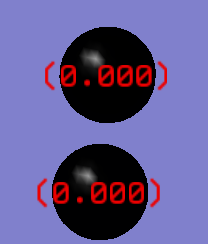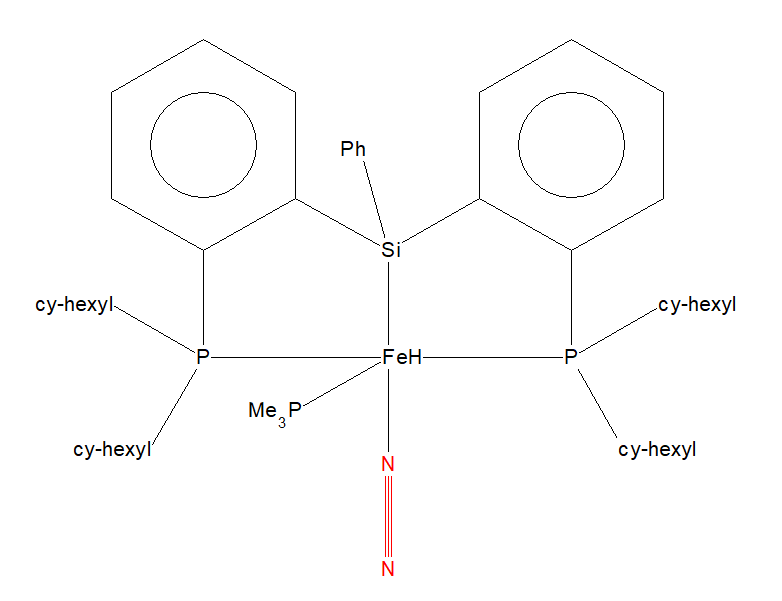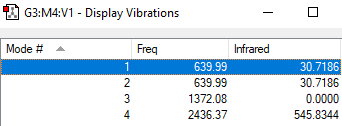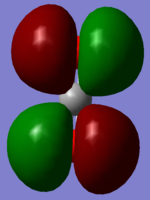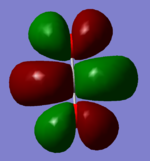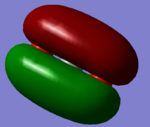Rep:Mod:ht4218
NH3
Ammonia Molecule |
| Feature | Result |
|---|---|
| N-H Bond Length (Å) | 1.018 |
| H-N-H Bond Angle (°) | 106 |
| Calculation Method | RB3LYP |
| Basis Set | 6-31G(d,p) |
| Final Energy E(RB3LYP) (au) | -56.55776873 |
| Point Group | C3v |
| Item | Value | Threshold | Converged? |
|---|---|---|---|
| Maximum Force | 0.000004 | 0.000450 | Yes |
| RMS Force | 0.000004 | 0.000300 | Yes |
| Maximum Displacement | 0.000072 | 0.001800 | Yes |
| RMS Displacement | 0.000035 | 0.001200 | Yes |
The optimisation file is linked to here
Vibrations and Vibrational Modes
| Wavenumber (cm-1) | 1090 | 1694 | 1694 | 3461 | 3590 | 3590 |
| Symmetry | A1 | E | E | A1 | E | E |
| Intensity (au) | 145 | 14 | 14 | 1 | 0 | 0 |
| Image |  |
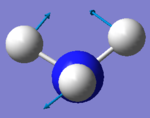 |
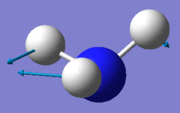 |
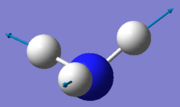 |
 |
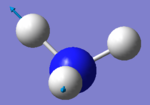
|
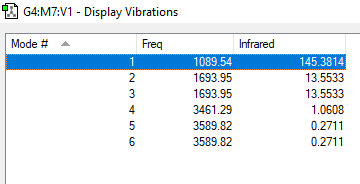
- The expected number of modes from the 3N-6 rule is 3(4)-6 = 6 modes.
- The modes at 1694cm-1 and 3590cm-1 are degenerate, meaning having the same energy.
- The bending modes are 1090cm-1 and 1694cm-1 because they are at a lower wavenumber and lower energy than stretching modes. The stretching modes are 3461cm-1 and 3590cm-1.
- The mode at 3461cm-1 is a highly symmetric stretch.
- The mode at 1090cm-1 is known as the umbrella (symmetric bend).
- Only the mode at 1090cm-1 and both modes at 1694cm-1 would produce bands on a spectrum as only they produce a change in dipole moment in the molecule. However, 2 of the bands will overlap as they have the same wavenumber, so only 2 distinct bands will form.
NBO Atomic Charges
The charge on the nitrogen atom is -1.125 and the charge on each hydrogen atom is 0.375.These values are expected because nitrogen is far more electronegative than hydrogen, so it would attract more of the electron density.
H2
Hydrogen Molecule |
| Feature | Result |
|---|---|
| H-H Bond Length (Å) | 0.743 |
| H-H Bond Angle (°) | 180 |
| Calculation Method | RB3LYP |
| Basis Set | 6-31G(d,p) |
| Final Energy E(RB3LYP) (au) | -1.17853930 |
| Point Group | D*h |
| Item | Value | Threshold | Converged? |
|---|---|---|---|
| Maximum Force | 0.000211 | 0.000450 | Yes |
| RMS Force | 0.000211 | 0.000450 | Yes |
| Maximum Displacement | 0.000278 | 0.001800 | Yes |
| RMS Displacement | 0.000393 | 0.001200 | Yes |
The optimisation file is linked to here.
Vibrations and Vibrational Modes
| Wavenumber (cm-1) | 4461 |
| Symmetry | SGG |
| Intensity (au) | 0 |
| Image |
NBO Atomic Charges
The charge on each hydrogen molecule is 0 because it is a diatomic molecule containing 2 atoms of the same element, so there is no difference in electronegativity.
N2
Nitrogen Molecule |
| Feature | Result |
|---|---|
| N-N Bond Length (Å) | 1.106 |
| N-N Bond Angle (°) | 180 |
| Calculation Method | RB3LYP |
| Basis Set | 6-31G(d,p) |
| Final Energy E(RB3LYP) (au) | -109.52412868 |
| Point Group | D*h |
| Item | Value | Threshold | Converged? |
|---|---|---|---|
| Maximum Force | 0.000001 | 0.000450 | Yes |
| RMS Force | 0.000001 | 0.000300 | Yes |
| Maximum Displacement | 0.000000 | 0.001800 | Yes |
| RMS Displacement | 0.000000 | 0.001200 | Yes |
The optimisation file is linked to here
Vibrations and Vibrational Modes
| Wavenumber (cm-1) | 2457 |
| Symmetry | SGG |
| Intensity (au) | 0 |
| Image | 
|
NBO Atomic Charges
Similar to other diatomic molcules containing 2 atoms of the same element, each nitrogen atom has a charge of 0 because of the even distribution of electrons.
Molecular Orbitals
 The lowest energy molecular orbital is a bonding orbital; its orbital energy is -14.44676 au.
The lowest energy molecular orbital is a bonding orbital; its orbital energy is -14.44676 au.
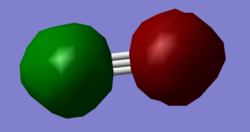 The second lowest energy molecular orbital is an anti-bonding orbital; its orbital energy is -14.44512 au.
The second lowest energy molecular orbital is an anti-bonding orbital; its orbital energy is -14.44512 au.
Mono-Metallic Transition Metal Complex
The nitrogen-nitrogen triple bond length for this complex is 1.149Å, which is longer than the bond length of 1.106Å in the N2 molecule. Therefore, this molecule will have a weaker bond strength, requiring less energy to break.
More information on this complex (VEJRUA), including its 3D structure, can be found here.
Haber-Bosch Reaction
N2 + 3H2 --> 2NH3
This is a fundamental reaction which combines hydrogen and nitrogen to form ammonia. It is very important as it produces NHN3 on a large, industrial scale, where lots of it is needed for use as a fertiliser.
Calculation
E(NH3)= -56.55776873 au
2*E(NH3)= −113.1155375 au
E(N2)= -109.52412868 au
E(H2)= -1.17853930 au
3*E(H2)= −3.5356179 au
ΔE=2*E(NH3)-[E(N2)+3*E(H2)]= −0.0557909 au
ΔE = −0.0557909*2625.5 = −146.479008 kJmol-1
ΔE = −146.5 kJmol-1 (1d.p.)
CO2
Carbon Dioxide Molecule |
| Feature | Result |
|---|---|
| C=O Bond Length (Å) | 1.169 |
| O=C=O Bond Angle (°) | 180 |
| Calculation Method | RB3LYP |
| Basis Set | 6-31G(d,p) |
| Final Energy E(RB3LYP) (au) | -188.58093945 |
| Point Group | D*h |
| Item | Value | Threshold | Converged? |
|---|---|---|---|
| Maximum Force | 0.000025 | 0.000450 | Yes |
| RMS Force | 0.000017 | 0.000300 | Yes |
| Maximum Displacement | 0.000022 | 0.001800 | Yes |
| RMS Displacement | 0.000015 | 0.001200 | Yes |
The optimisation file is linked to here
Vibrations and Vibrational Modes
| Wavenumber (cm-1) | 640 | 640 | 1372 | 2436 |
| Symmetry | PIU | PIU | SGG | SGU |
| Intensity (au) | 31 | 31 | 0 | 546 |
| Image |  |
 |
 |

|
NBO Atomic Charges
The charge on the carbon atom is 1.022 and the charge on each oxygen is -0.511. Oxygen has a lower charge because it is a more electronegative element than carbon, therefore it will attract the electrons in the bond.
Molecular Orbitals
Comparison to CS2
Carbon Disulfide Molecule |
The optimised C=S bond length is 1.563Å, which is longer than the C=O bond length of 1.169Å. This can be explained by the fact that sulfur is a larger element than oxygen, so its valence electrons are in larger orbitals. These orbitals will have worse overlap with the smaller s and p orbitals in carbon, resulting in the formation of a weaker, and therefore longer, bond.
Marking
Note: All grades and comments are provisional and subjecct to change until your grades are officially returned via blackboard. Please do not contact anyone about anything to do with the marking of this lab until you have recieved your grade from blackboard.
Wiki structure and presentation 1/1
Is your wiki page clear and easy to follow, with consistent formatting?
YES
Do you effectively use tables, figures and subheadings to communicate your work?
YES
NH3 1/1
Have you completed the calculation and given a link to the file?
YES
Have you included summary and item tables in your wiki?
YES
Have you included a 3d jmol file or an image of the finished structure?
YES
Have you included the bond lengths and angles asked for?
YES
Have you included the “display vibrations” table?
YES
Have you added a table to your wiki listing the wavenumber and intensity of each vibration?
YES
Did you do the optional extra of adding images of the vibrations?
YES
Have you included answers to the questions about vibrations and charges in the lab script?
YES
N2 and H2 0/0.5
Have you completed the calculations and included all relevant information? (summary, item table, structural information, jmol image, vibrations and charges)
YES - however, you stated a bond angle for diatomic molecules. To define a bond angle a minimum of 3 atoms is needed!
Crystal structure comparison 0.5/0.5
Have you included a link to a structure from the CCDC that includes a coordinated N2 or H2 molecule?
YES
Have you compared your optimised bond distance to the crystal structure bond distance?
YES
Haber-Bosch reaction energy calculation 0.5/1
Have you correctly calculated the energies asked for? ΔE=2*E(NH3)-[E(N2)+3*E(H2)]
YES
Have you reported your answers to the correct number of decimal places?
YES
Do your energies have the correct +/- sign?
YES
Have you answered the question, Identify which is more stable the gaseous reactants or the ammonia product?
NO - You missed to interpret your result.
Your choice of small molecule 2.5/5
Have you completed the calculation and included all relevant information?
YES
Have you added information about MOs and charges on atoms?
You have done a good job of presenting this information, well done! You should have explained the calculated vibrations as you did for NH3. You correctly stated the energies of the MOs. However you missed to comment on which MO is occupied and which is not. additionally, you only give less than minimum information on the contributing AOs and messed up bonding/non-bonding/anti-bonding MOs.
Independence 0.5/1
If you have finished everything else and have spare time in the lab you could: Check one of your results against the literature, or Do an extra calculation on another small molecule, or
YES - however, you missed to include a link to your optimised .log file.
Do some deeper analysis on your results so far



